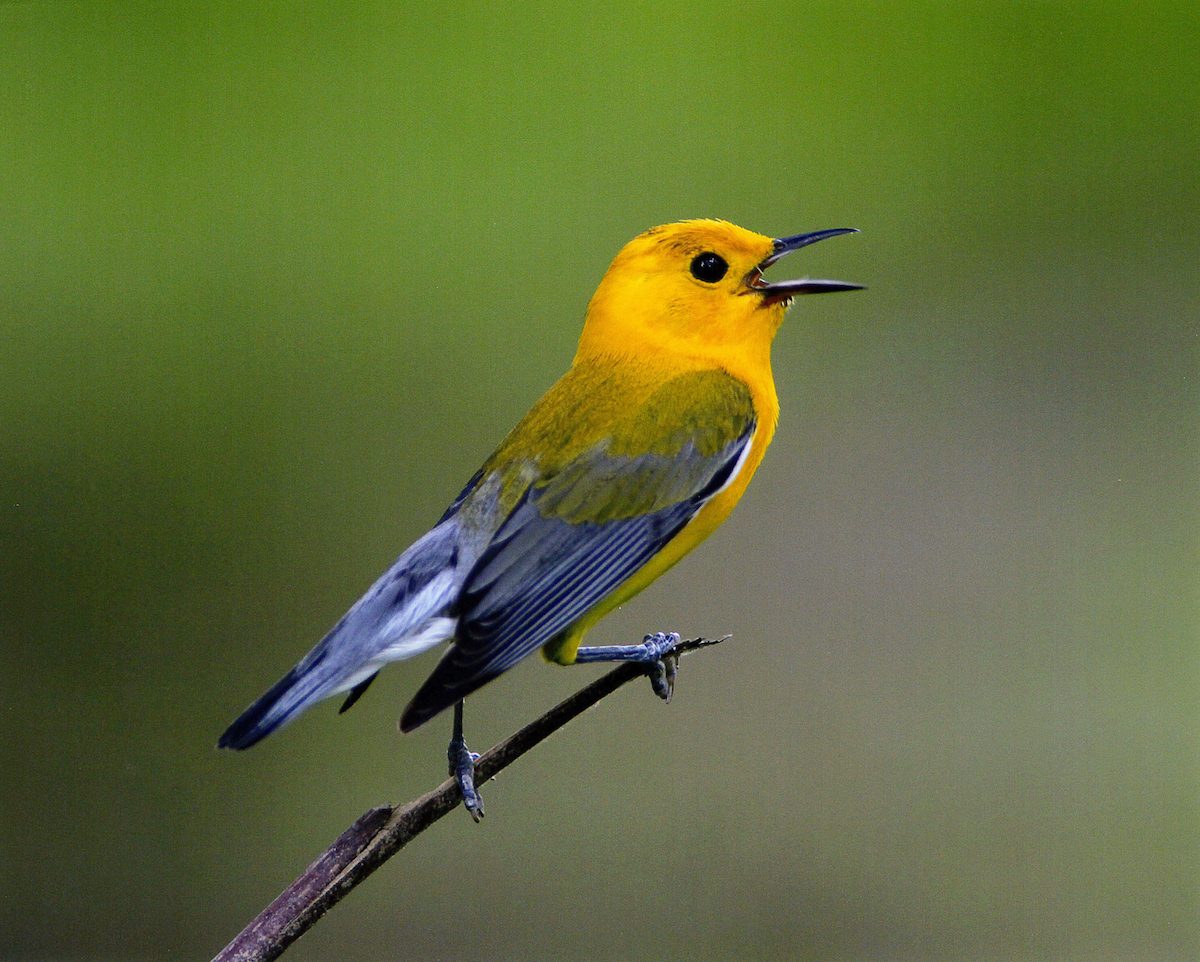Learn what a prothonotary warbler looks like and sounds like and where to find one. Plus learn about their nesting habits and diet.

Identify and Attract a Prothonotary Warbler

On This Page
What Does a Prothonotary Warbler Look Like?

Prothonotary warblers are yellow with slate blue wings. Males are more brightly colored, especially on the head. Their dark eyes stand out against the sunny yellow plumage. Juvenile birds are more dull in color.
According to the Audubon Guide to North American Birds, this species’ name originally referenced a group of Catholic Church scribes who dressed in yellow hoods.
A similar looking bird is the yellow warbler, however, this species is smaller in size.
Prothonotary Warbler Nesting Habits

Unlike other warblers, the prothonotaries are cavity nesters. They nest in holes in trees instead of out in the open. Woodpeckers are known for hammering out holes, but once they leave their homemade tree houses behind, these warblers take up residence in the woodpeckers’ excavated apartments. Females lay three to seven white eggs with dark speckles.
Kate Slankard, avian biologist with the Kentucky Department of Fish and Wildlife Resources, says, “Pairs are monogamous—at least for each breeding season. Both parents feed the young after fledging.”
During breeding season, look for these sweet-faced birds snapping their bills at intruders.
Do Prothonotary Warblers Use Birdhouses?

These stunning yellow birds also use manmade bird boxes. “Prothonotary warblers nest in areas where people can see them,” says Deloras Freeman, visitor services manager of the Great Dismal Swamp, a national wildlife refuge in Virginia and North Carolina.
Prothonotary warblers may choose to nest in a birdhouse in your yard, especially if there are swampy woods nearby. These birds prefer nest boxes placed 4 to 12 feet high that look out over the water.
Visit Project Nestwatch for plans to make your own warbler birdhouse.
Diet: What Do Prothonotary Warblers Eat?

Most warblers forgo bird feeders. Make sure your yard is providing plenty of insects, the food they love most.
Insects are crucial to a warbler’s diet, and they have to eat a lot of them. From mosquitoes to aphids, these birds are natural pesticides because they consume many kinds of insects. Add native plants and host plants for butterflies to boost the number of caterpillars and other bugs in your yard—and bring in the insect-eating birds.
Kate adds that this warbler might visit your birdbath or berry bushes.
“This is not a species you will typically see at bird feeders, but they may visit birdbaths or water drips during migration. They primarily eat insects during the breeding season, but fruit may be consumed during migration and winter,” she says. “We have caught this species during fall migration while banding songbirds, and on more than one occasion, we have caught birds that have had the stain of sumac berries around their bills. Although this was perhaps an unusual observation, native shrubs that produce fall fruit might attract this and other migrating songbirds.”
Learn how to identify yellow-rumped warblers.
Prothonotary Warbler Song

This small bird has a loud song. “The pneumonic I use for this bird is “sweet-sweet-sweet-sweet”! Their song is quite cheerful and loud when you are close to them!” says Kate.
Bird sounds courtesy of the Cornell Lab of Ornithology
Prothonotary Warbler Range and Habitat

Their breeding range covers most of the eastern U.S., although they aren’t as common in northern states and are completely absent from the far northeast.
This species is of conservation concern throughout most of its range due to declining numbers.
Kate says, “In this part of the country, the species is associated with bottomland hardwoods forests and forests near lakes and streams.” She then adds, “Southeastern bottomland hardwood forests are a habitat that we don’t have near enough of anymore. This habitat type supports much-loved bird species such as bald eagles, red-headed woodpeckers, prothonotary warblers and rusty blackbirds (in the winter). However, most of these areas were cleared for agriculture decades ago. Prothonotary warblers are a cheerful reminder to us to conserve and restore this important habitat type.”
About the Experts
Kate Slankard is an avian and wildlife biologist with the Kentucky Department of Fish and Wildlife Resources. Kate has conducted research on barn owl nesting sites in an effort to determine why the species is rare in the state.
Deloras Freeman is the the visitor services manager of the Great Dismal Swamp, a nearly 113,000 acre national wildlife refuge in Virginia and North Carolina. The diverse ecosystem provides habitat for more than 200 species of birds.
Sources
- Project NestWatch
- National Audubon Society – prothonotary warbler




















